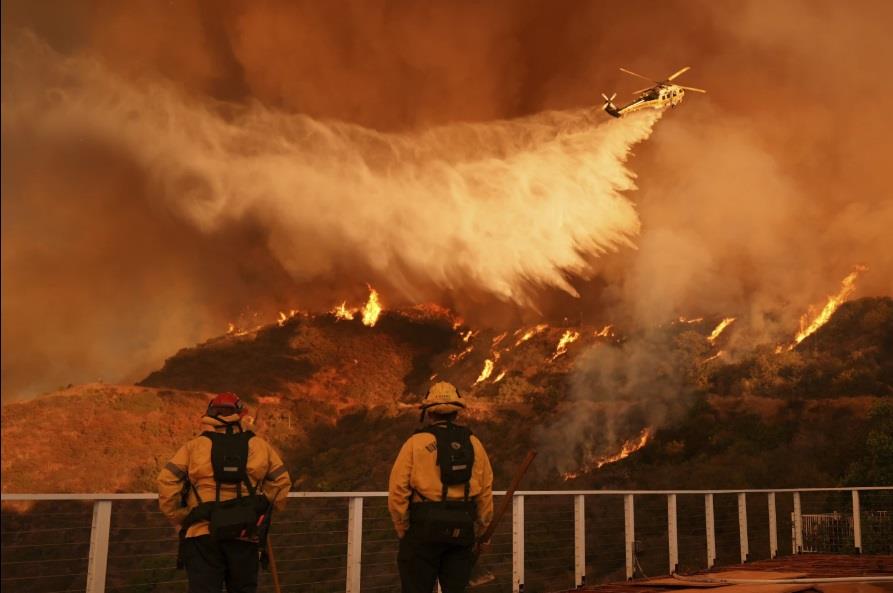
California's Burning Winter: A Warning From Nature?
Typically, fire season in Southern California occurs between May and October. However, climate change is expanding this timeline. Rising temperatures and declining precipitation have transformed the region's fire season into a year-round phenomenon. The dry start to this winter, combined with unusually high temperatures, has created perfect conditions for wildfires.
What's Fueling These Fires?
Read Also Strong Winds Forecast For Los Angeles Threaten Area's Fight Against Fires 24 Dead As Fire Crews Try To Corral Los Angeles Blazes Before Winds Return This WeekThe two main culprits behind the fires' intensity are the Santa Ana winds and an abundance of dried vegetation. Santa Ana winds, which usually blow in the fall and winter, are fierce and dry. As they travel from the high desert areas to the coast, they compress and heat up, further drying out vegetation. This season, gusts have reached speeds of 145 kilometers (90 miles) per hour, fanning flames and spreading embers with devastating efficiency.
Adding to the problem is the dried-out vegetation. Southern California experienced a very wet year in 2024, which led to the growth of abundant grass and brush. However, the driest start to winter on record has turned this vegetation into fire-ready fuel, amplifying the fires' spread.
Is Climate Change to Blame?
While pinpointing individual wildfires to climate change can be challenging, it is clear that human-caused climate change is worsening conditions for wildfires in California. Rising temperatures, drier winters, and more erratic weather patterns-sometimes referred to as“weather whiplash”-create conditions that make wildfires more intense and frequent. Wetter years encourage vegetation growth, while drier years prime this vegetation for burning.
What About the Health Impacts?
The fires are not just destroying land and property-they're also endangering public health. Wildfire smoke contains fine particulates that can harm lungs, increase heart attack risks, and shorten life expectancy. The smoke from the Palisades Fire has already caused unhealthy air quality in Los Angeles County, with children, older adults, pregnant individuals, and those with respiratory or immune conditions being at the highest risk.
Health officials warn residents to monitor air quality and take precautions.“Smoke and ash can harm everyone,” said Muntu Davis, a health officer for Los Angeles County. Staying indoors, using air purifiers, and wearing masks are essential steps for protecting health during this crisis.
What's Next?
California's wildfires are a stark reminder of the growing challenges posed by climate change. Efforts to mitigate the risks will require addressing the root causes of climate change and investing in fire prevention and management strategies. For now, residents in affected areas must prioritize safety and remain vigilant as these blazes continue to burn.
Will this be the costliest wildfire disaster in U.S. history? As the Palisades Fire and its counterparts wreak havoc, experts fear this may well be the case.
A Warning from Nature
The wildfires raging across California are more than just natural disasters-they are urgent warnings from nature. Human-driven climate change is pushing the planet to its limits, turning once-predictable seasons into unpredictable cycles of extremes. Wetter years bring abundant vegetation, while hotter and drier years transform it into kindling for devastating fires.
These patterns underscore the profound impact of our choices. The burning forests, smoldering homes, and polluted air are stark reminders that the natural world is not separate from us-it reflects our actions. Addressing climate change is no longer optional; it is a necessity. It requires bold steps to reduce emissions, adopt sustainable practices, and safeguard ecosystems.
The message from nature is clear: we must act now, or the warnings will only grow louder and more destructive.
- The author has a PG in Biotechnology and is Administrator at Maryam Memorial Institute Pandithpora Qaziabad. He tweets @IkkzIkbal
Follow this link to join our WhatsApp group : Join Now
| Be Part of Quality Journalism |
| Quality journalism takes a lot of time, money and hard work to produce and despite all the hardships we still do it. Our reporters and editors are working overtime in Kashmir and beyond to cover what you care about, break big stories, and expose injustices that can change lives. Today more people are reading Kashmir Observer than ever, but only a handful are paying while advertising revenues are falling fast. |
| ACT NOW |
| MONTHLY | Rs 100 | |
| YEARLY | Rs 1000 | |
| LIFETIME | Rs 10000 | |
CLICK FOR DETAILS

Legal Disclaimer:
MENAFN provides the information “as is” without warranty of any kind. We do not accept any responsibility or liability for the accuracy, content, images, videos, licenses, completeness, legality, or reliability of the information contained in this article. If you have any complaints or copyright issues related to this article, kindly contact the provider above.






















Comments
No comment